Table of Contents
- Introduction
- Editor’s Choice
- History of Skateboarding
- Skateboard Market Statistics
- Skateboard Export Statistics
- Skateboard Import Statistics
- The Popularity of Skateboard in the United States Statistics
- Popularity of Skateboard in the United Kingdom Statistics
- Demographics of Skateboarding Participants
- Top Male Skaters
- Skateboard Motivations for Skateboarding Statistics
- Skateboard Top Concerns and Statistics
- Skateboard Regulations for Skateboarding Statistics
- Recent Developments
- Conclusion
- FAQs
Introduction
Skateboard Statistics: Skateboarding involves riding a skateboard, which consists of a deck, trucks, wheels, and bearings.
The deck is the flat board where the rider stands, while the trucks attach the wheels and are adjustable for turning.
Wheels, made of urethane, vary in hardness and size, affecting grip and ride smoothness. Bearings which are inside the wheels ensure smooth rotation and are rated by the ABEC scale.
Skaters use grip tape on the deck for traction and perform basic skills like pushing, stopping, and turning.
Fundamental tricks include the Ollie, Kickflip, and Grind. Safety gear, including helmets, knee and elbow pads, and wrist guards, is crucial for protection.
Skateboarding also encompasses a vibrant culture with diverse styles. Such as street and vert skating, fostering a global community through competitions and local events.
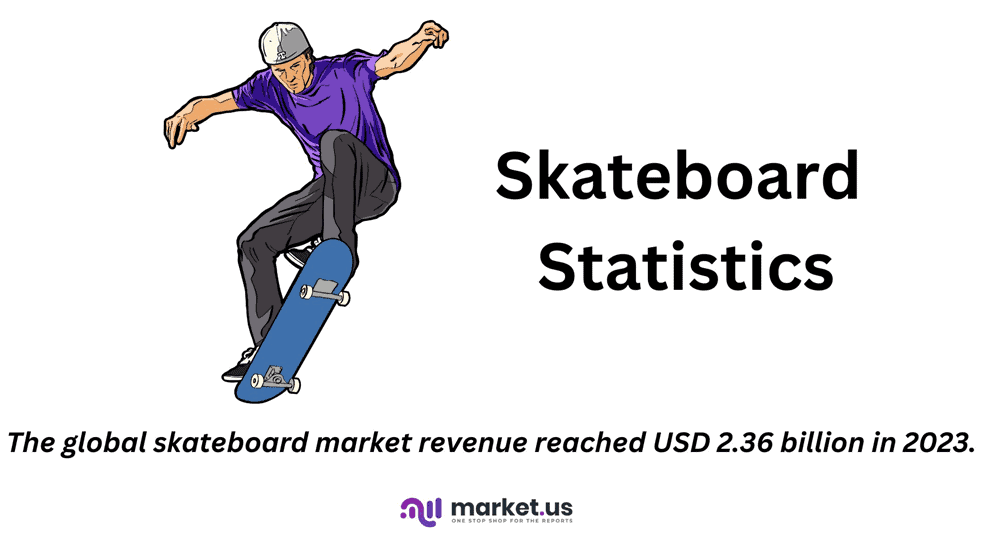
Editor’s Choice
- The global skateboard market revenue reached USD 2.36 billion in 2023.
- The competitive landscape of the skateboard market is characterized by a diverse array of key players, each holding a significant market share. Element Skateboards leads the market with a 14% share. Closely followed by Krown Skateboards and Absolute Board, each commanding 12% of the market.
- The global skateboard market is distributed across various regions, each contributing significantly to the overall market dynamics. North America holds the largest share, accounting for 33.7% of the market. Driven by a strong skateboarding culture and established industry presence.
- In 2022, the global export market for ice skates, roller skates, and skating boots was dominated by China. Which accounted for a significant 59.9% of the total export value, amounting to USD 600 million.
- In 2022, the United States emerged as the leading importer of ice skates, roller skates, and skating boots. With imports valued at USD 195 million, accounting for 19.4% of the global import market.
- The number of skateboarding participants in the United States reached 8.92 million in 2023.
- A survey on the reasons why individuals skateboard revealed a variety of motivations among respondents. The majority, 76%, cited having fun as their primary reason for skateboarding.
- A survey of skateboarders under the age of 26 revealed various concerns across different demographic groups. Financial issues were the top concern for all groups, with 74% of all skaters, 68% of female skaters, and 68% of skaters of color indicating this as a primary concern.
History of Skateboarding
- The history of skateboarding is a fascinating journey that began in the 1940s and 1950s when surfers in California sought to replicate the sensation of riding waves on land. Early skateboarders fashioned their boards by attaching roller skate wheels to wooden planks.
- By the late 1950s, commercial production of skateboards commenced, leading to the establishment of companies like Roller Derby.
- The 1960s marked the introduction of the first skateboarding competition. The National Skateboarding Championship in 1963, and the innovation of the kicktail, allowed for more advanced tricks.
- The 1970s saw the invention of urethane wheels by Frank Nasworthy. Significantly improving the skateboard’s performance and leading to the construction of the first skateparks.
- The Ollie, a groundbreaking trick invented by Alan Gelfand in 1978, further revolutionized the sport.
- The 1980s brought about the rise of skateboarding subcultures and iconic brands like Powell Peralta and Vision, with skateboarding becoming a prominent part of youth culture.
- In the 1990s, skateboarding’s popularity surged globally, aided by the X Games and video games like “Tony Hawk’s Pro Skater.”
- The 2000s and 2010s saw continued growth and diversification. Skateboarding making its Olympic debut at the Tokyo 2020 Games. Underscoring its evolution from a niche activity to a globally recognized sport and lifestyle.
(Sources: Sports Foundation, Skateboard Salad, Red Bull)
Skateboard Market Statistics
Global Skateboard Market Size Statistics
- The global skateboard market has demonstrated a consistent growth trajectory over the past decade at a CAGR of 3.2%. Reflecting increasing consumer interest and industry expansion.
- In 2021, the market revenue stood at USD 2.22 billion, followed by an incremental rise to USD 2.29 billion in 2022 and USD 2.36 billion in 2023.
- The upward trend continues with projected revenues of USD 2.44 billion in 2024, USD 2.52 billion in 2025, and USD 2.60 billion in 2026.
- By 2027, the market is expected to reach USD 2.68 billion. Subsequently growing to USD 2.77 billion in 2028 and USD 2.86 billion in 2029.
- The revenue is forecasted to further increase to USD 2.95 billion in 2030 and USD 3.04 billion in 2031.
- Projections for 2032 and 2033 indicate a sustained growth pattern. With market revenues anticipated to reach USD 3.14 billion and USD 3.24 billion, respectively.
- This steady increase underscores the robust demand and the expanding consumer base within the skateboard market.
(Source: market.us)
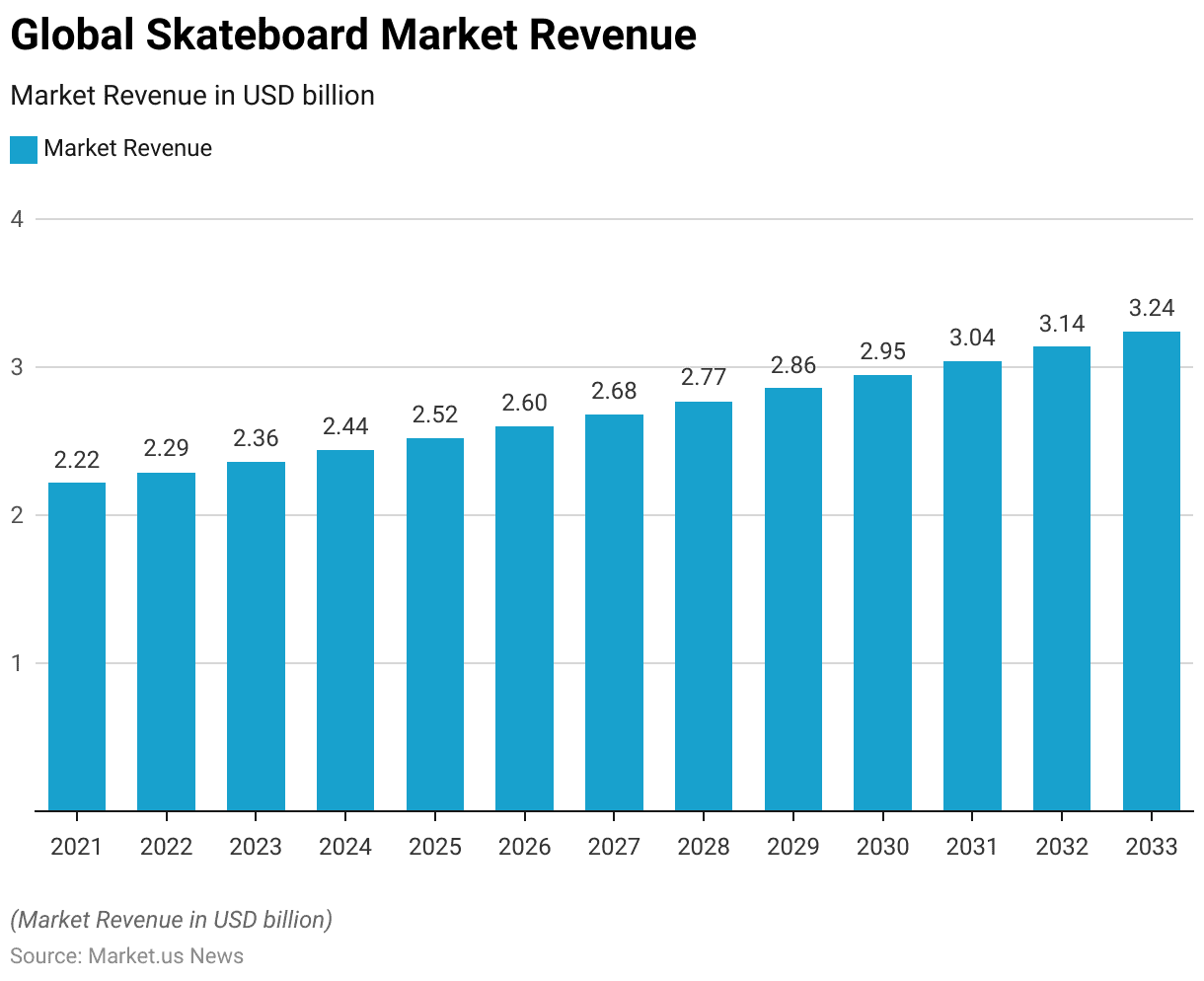
Global Skateboard Market Size – By Product Type Statistics
2015-2020
- The skateboard market in the United States has experienced notable growth across various product types from 2015 to 2020.
- In 2015, the market value for street boards was USD 268.8 million, followed by cruiser boards at USD 111.6 million, longboards at USD 104.8 million, and other types at USD 38.7 million.
- By 2016, street boards saw a slight increase to USD 273.1 million. While cruiser boards decreased slightly to USD 110.2 million. Longboards and other types recorded values of USD 105.6 million and USD 34.4 million, respectively.
- In 2017, the market for street boards slightly declined to USD 270.8 million. While cruiser boards rose to USD 112.5 million, and longboards remained at USD 105.6 million, with other types increasing to USD 39 million.
- The market showed a steady upward trend from 2018 onwards. By 2019, street boards reached USD 275.4 million. Cruiser boards remained at USD 114.8 million. Longboards increased to USD 112.5 million, and other types saw a decrease to USD 36.7 million.
- In 2020, street boards rose to USD 277.7 million, cruiser boards to USD 121.6 million, long boards to USD 114.8 million, and other types maintained a value of USD 39 million.
2021-2025
- The year 2021 saw further growth, with street boards at USD 286.9 million, cruiser boards at USD 119.3 million, longboards at USD 117.1 million, and other types at USD 41.3 million.
- From 2022 to 2025, the market continued its positive trajectory. In 2022, street boards reached USD 296.1 million, cruiser boards USD 126.2 million, longboards USD 117.1 million, and other types USD 43.6 million.
- By 2023, street boards were valued at USD 303 million, cruiser boards at USD 128.5 million, longboards at USD 123.9 million, and other types remained at USD 43.6 million.
- Projections for 2024 and 2025 indicate continued growth. With street boards expected to reach USD 312.1 million and USD 323.6 million, cruiser boards USD 135.4 million and USD 142.3 million, longboards USD 128.5 million and USD 135.4 million, and other types USD 45.9 million and USD 48.2 million, respectively.
- This consistent growth across all product types highlights the expanding popularity and market demand for skateboards in the United States.
(Source: Statista)
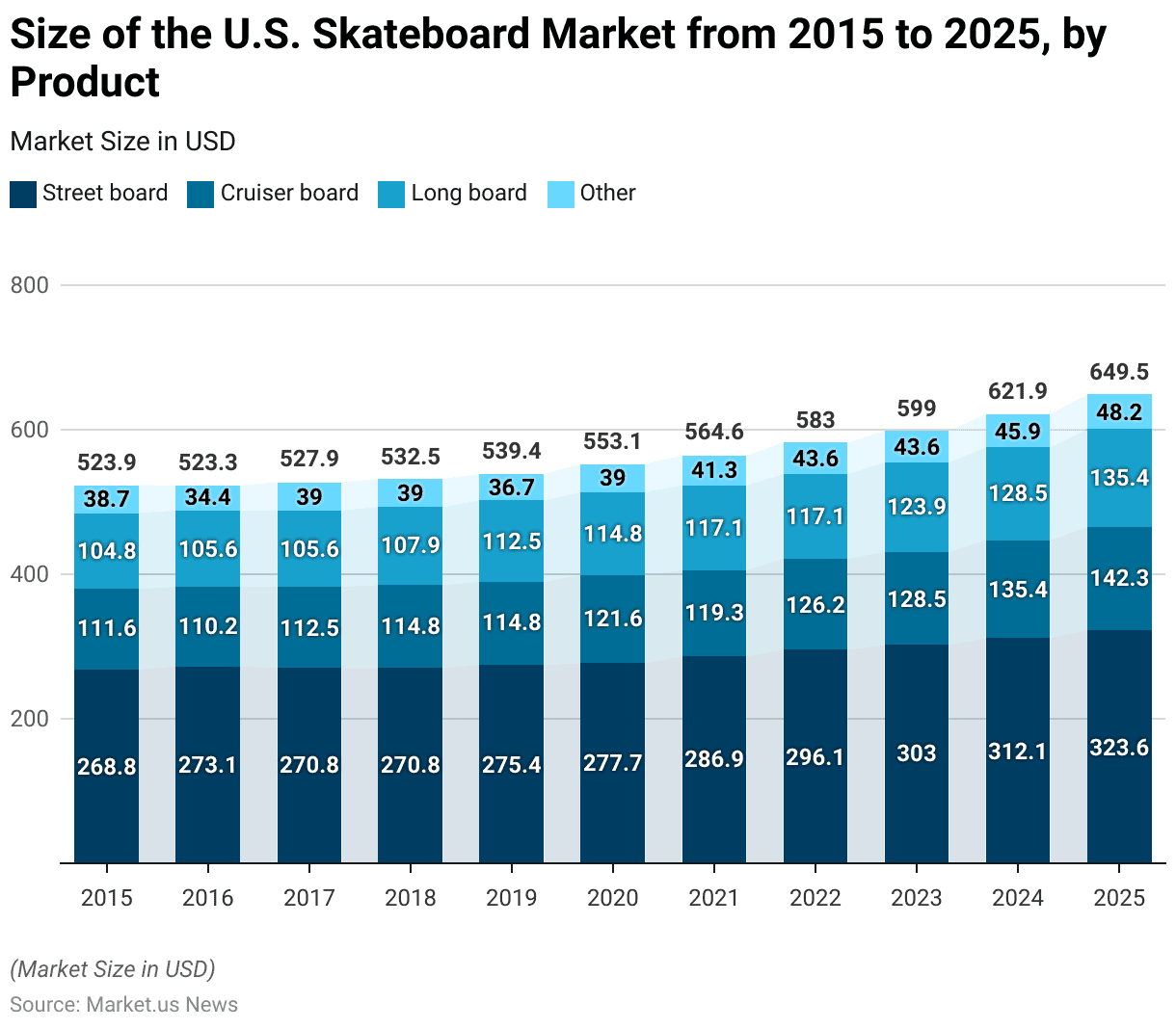
Competitive Landscape of the Global Skateboard Market Statistics
- The competitive landscape of the skateboard market is characterized by a diverse array of key players, each holding a significant market share.
- Element Skateboards leads the market with a 14% share. Closely followed by Krown Skateboards and Absolute Board, each commanding 12% of the market.
- SK8FACTORY holds an 11% share, while Alien Workshop and Artprint account for 10% and 9% of the market, respectively.
- Zero Skateboards has an 8% market share, and Control Skateboards holds a 7% share.
- Collectively, other key players in the market constitute 17%. Highlighting the presence of numerous influential brands contributing to the market’s overall dynamics.
(Source: market.us)
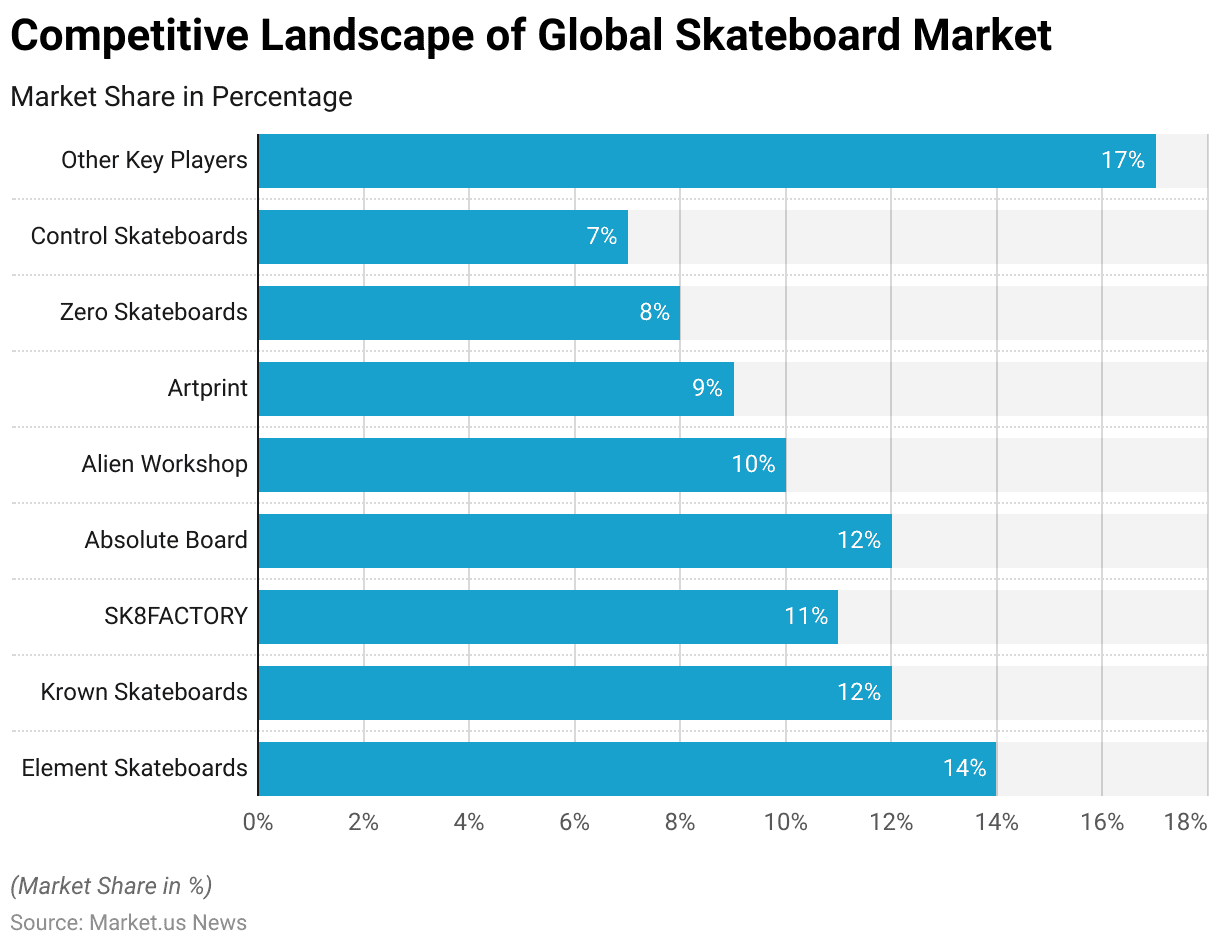
Regional Analysis of the Global Skateboard Market Statistics
- The global skateboard market is distributed across various regions, each contributing significantly to the overall market dynamics.
- North America holds the largest share, accounting for 33.7% of the market. Driven by a strong skateboarding culture and established industry presence.
- The Asia-Pacific (APAC) region follows closely with a 30.2% share, reflecting rapid growth and increasing popularity of the sport.
- Europe contributes 24.3% to the market, supported by a robust skateboarding community and infrastructure.
- South America, the Middle East, and Africa (MEA) regions, while smaller in comparison, account for 7.6% and 4.2% of the market, respectively. Indicating emerging interest and potential for future growth in these areas.
(Source: market.us)
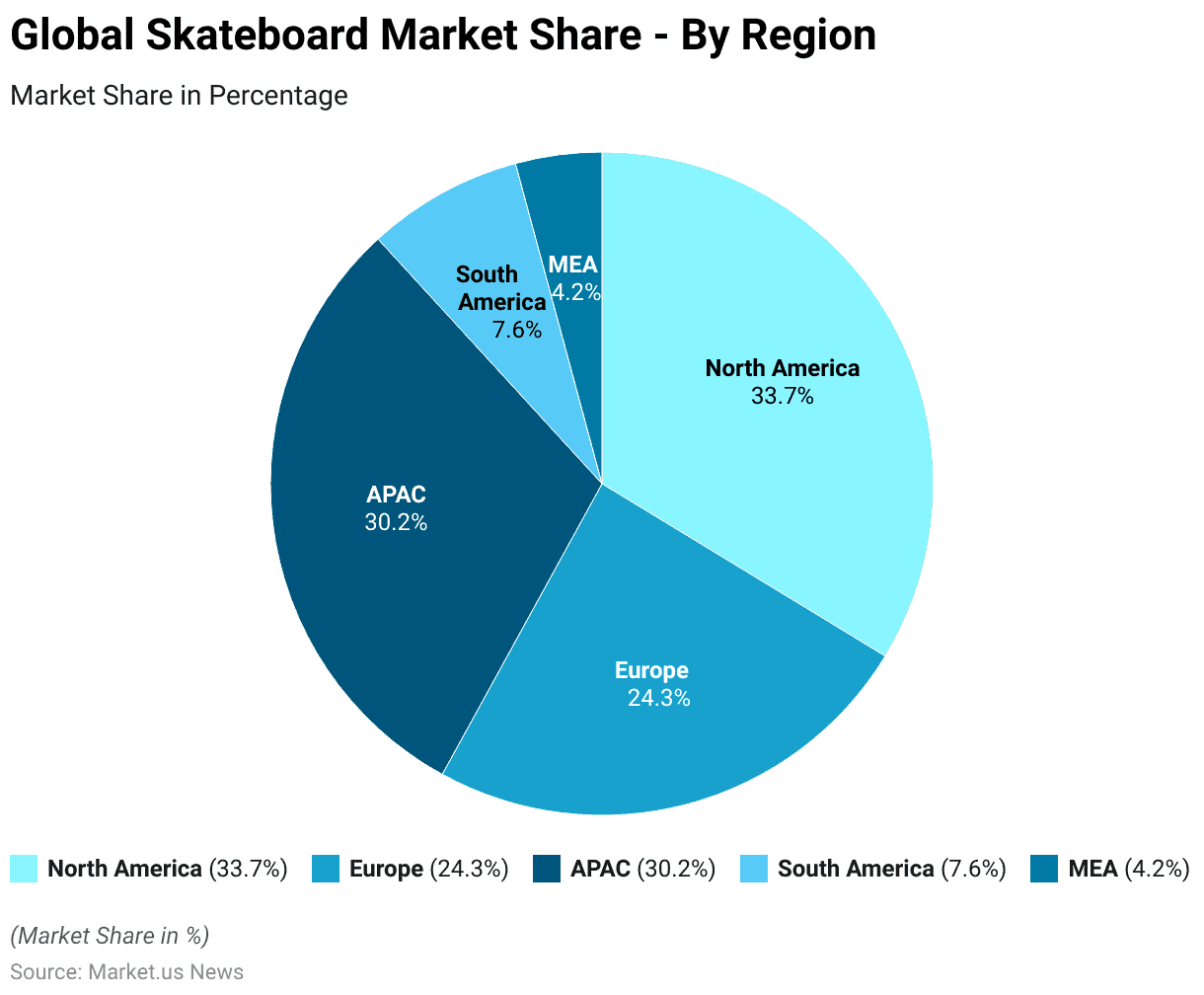
Skateboard Export Statistics
- In 2022, the global export market for ice skates, roller skates, and skating boots was dominated by China. Which accounted for a significant 59.9% of the total export value, amounting to USD 600 million.
- Vietnam followed distantly, with exports valued at USD 54 million, representing 5.39% of the market.
- Italy held a 4.13% share with exports worth USD 41.3 million, while Thailand and Germany contributed USD 34.7 million and USD 33.6 million, corresponding to 3.47% and 3.35% of the market, respectively.
- France exported USD 31.7 million worth of these products, capturing a 3.17% share.
- Canada and Sweden each held modest shares of 2.45% and 2.37%, with export values of USD 24.6 million and USD 23.7 million, respectively.
- Cambodia contributed USD 20.3 million, or 2.03% of the market. Followed by the United States with USD 18.1 million (1.8%) and Spain with USD 17.9 million (1.78%).
- The Netherlands and Chinese Taipei each had smaller shares. Exporting USD 11.3 million (1.13%) and USD 10.7 million (1.07%), respectively.
- Malaysia’s exports were valued at USD 10.3 million, constituting 1.03% of the market. While Poland accounted for 0.99%, with exports worth USD 9.91 million.
- This data highlights the significant contributions of these countries to the global market for skating equipment in 2022.
(Source: OEC World)
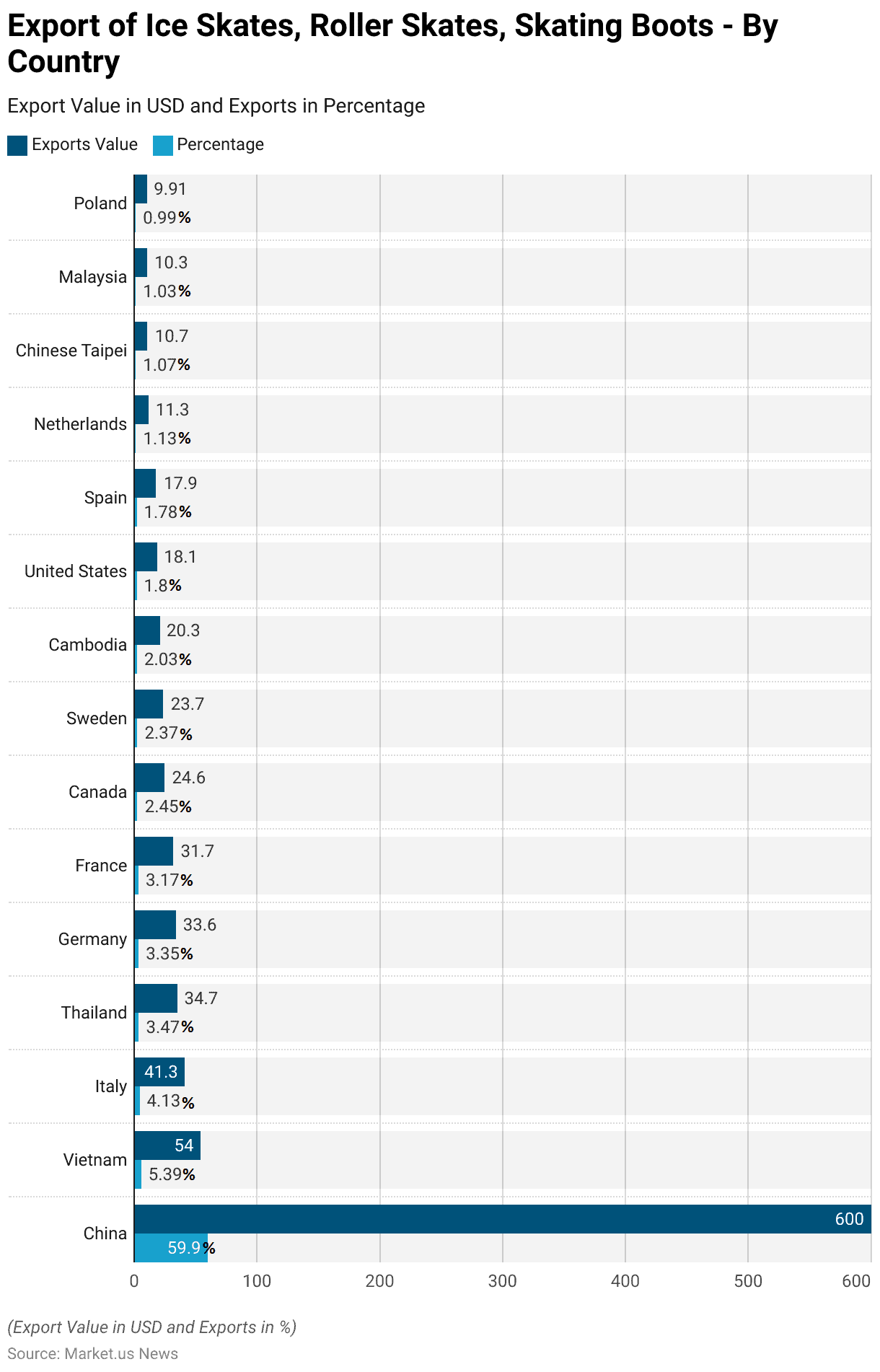
Skateboard Import Statistics
- In 2022, the United States emerged as the leading importer of ice skates, roller skates, and skating boots, with imports valued at USD 195 million, accounting for 19.4% of the global import market.
- Germany followed with an import value of USD 88.1 million, representing 8.8% of the market.
- Canada imported USD 81.7 million worth of these products, capturing an 8.15% share.
- France and Poland also had significant shares, importing USD 49.7 million (4.96%) and USD 46.9 million (4.68%), respectively.
- Italy’s imports were valued at USD 41.6 million, constituting 4.15% of the market, while the
- Netherlands and Russia imported USD 34.2 million (3.41%) and USD 33 million (3.29%), respectively.
- Spain followed closely with imports worth USD 31.3 million, accounting for 3.12% of the market.
- Czechia and Sweden each held similar shares, with import values of USD 29.6 million (2.95%) and USD 29.5 million (2.94%), respectively.
- The United Kingdom imported USD 22.8 million worth of skating equipment, making up 2.28% of the market, while Mexico imported USD 22.5 million, representing 2.25%.
- Finland’s imports were valued at USD 14.8 million (1.48%), and Switzerland accounted for 1.25% of the market with imports worth USD 12.5 million.
- This distribution highlights the diverse and widespread demand for skating equipment across these key importing nations in 2022.
(Source: OEC World)
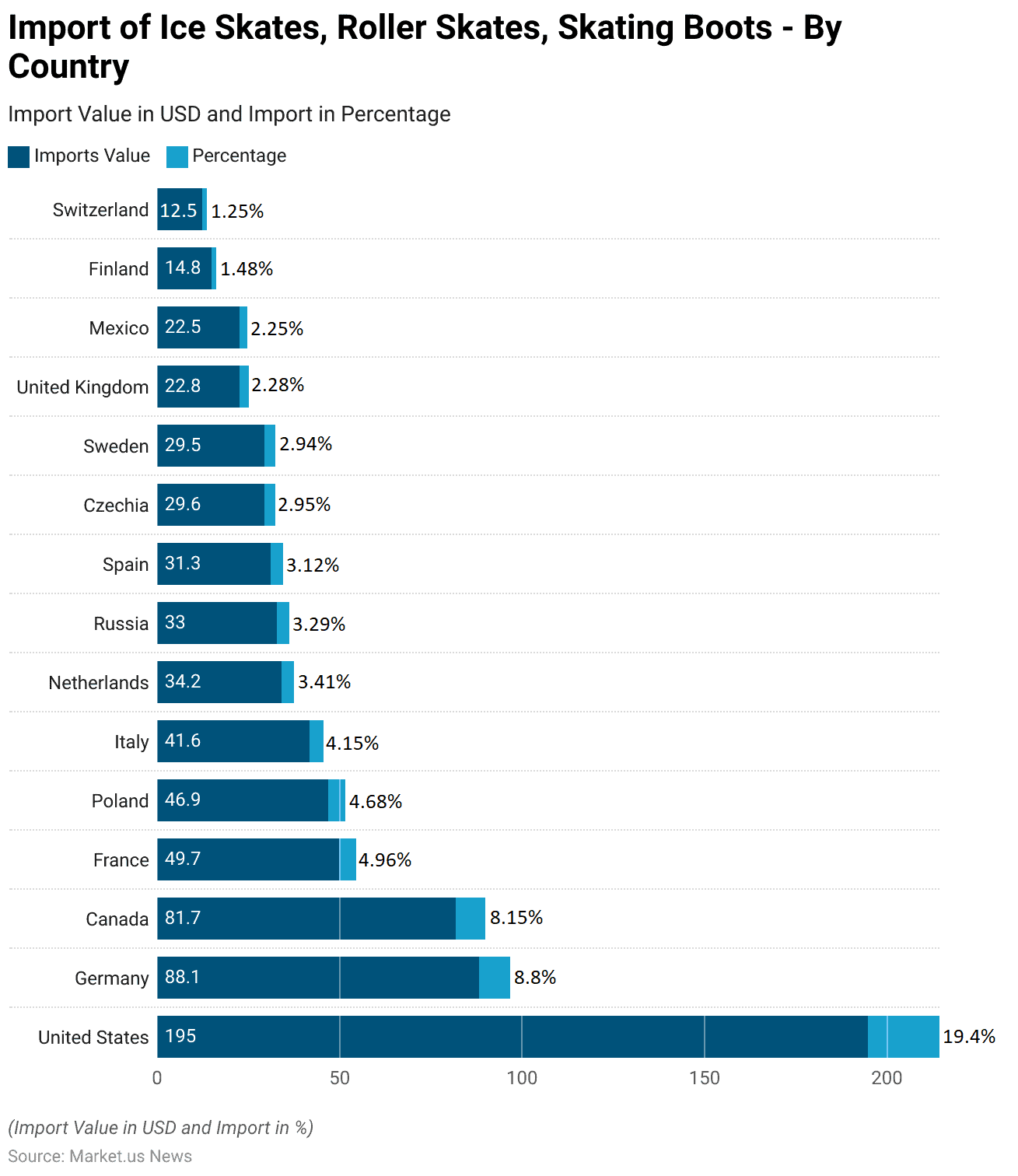
The Popularity of Skateboard in the United States Statistics
Skateboarding Participation in the United States
- The number of skateboarding participants in the United States has exhibited fluctuating trends from 2010 to 2023.
- In 2010, the skateboarding population was recorded at 7.08 million.
- This figure declined to 6.32 million in 2011 and further to 6.23 million in 2012.
- A slight increase was observed in 2013, with the number rising to 6.35 million, followed by a gradual climb to 6.58 million in 2014.
- The participation numbers then experienced minor variations, with 6.44 million participants in both 2015 and 2016 and a slight dip to 6.38 million in 2017.
- In 2018, the number of participants increased to 6.5 million, continuing to rise to 6.61 million in 2019.
- A significant surge occurred in 2020, with the skateboarding population reaching 8.87 million, likely influenced by increased interest in outdoor activities during the COVID-19 pandemic.
- Although there was a slight decrease to 8.75 million in 2021, the number of participants grew again to 9.02 million in 2022.
- In 2023, the participation rate slightly decreased to 8.92 million.
- This data reflects the dynamic nature of skateboarding popularity in the United States over the past decade, with notable growth in recent years.
(Source: Statista)
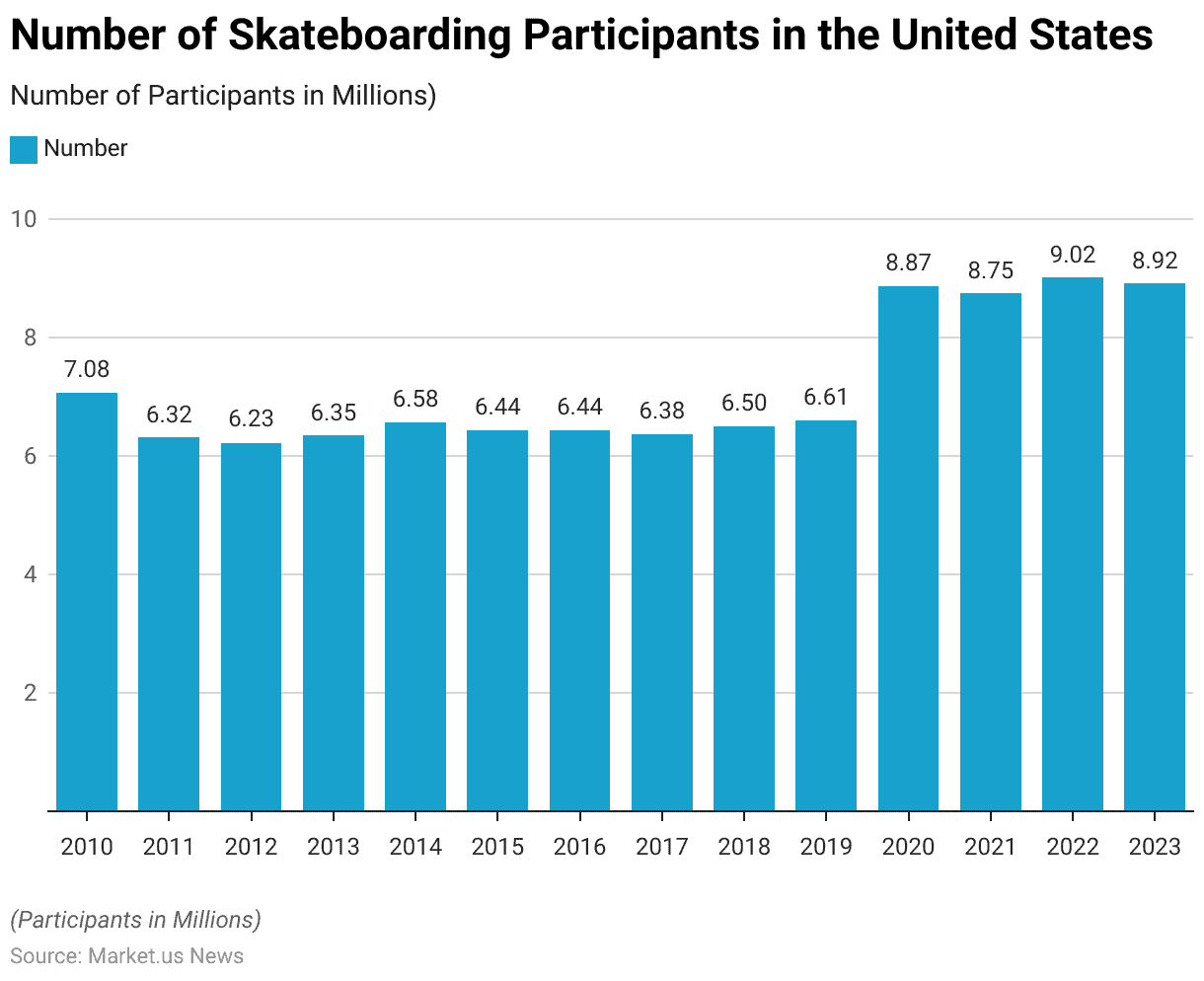
Skating Association Membership in the United States
- The total membership of U.S. Figure Skating has experienced fluctuations from the 2010-11 season through the 2021-22 season.
- In 2010-11, the membership stood at 180,000.
- This number declined over the next few years, reaching 173,000 in 2011-12 and further dropping to 165,000 in 2012-13.
- A slight recovery occurred in 2013-14, with membership increasing to 170,660.
- The trend continued upward, reaching 178,320 in 2014-15 and 181,700 in 2015-16.
- The growth persisted, with membership rising to 184,210 in 2016-17 and further to 192,110 in 2017-18.
- The peak occurred in 2018-19, with a membership of 202,020.
- However, a decline followed, with membership falling to 186,040 in 2019-20.
- A significant drop was observed during the 2020-21 season, with membership plummeting to 133,410, likely influenced by the COVID-19 pandemic.
- The following season, 2021-22, saw a remarkable rebound, with membership soaring to 222,890.
- This data reflects the dynamic nature of U.S. Figure Skating’s membership over the past decade, marked by periods of growth and decline.
(Source: Statista)
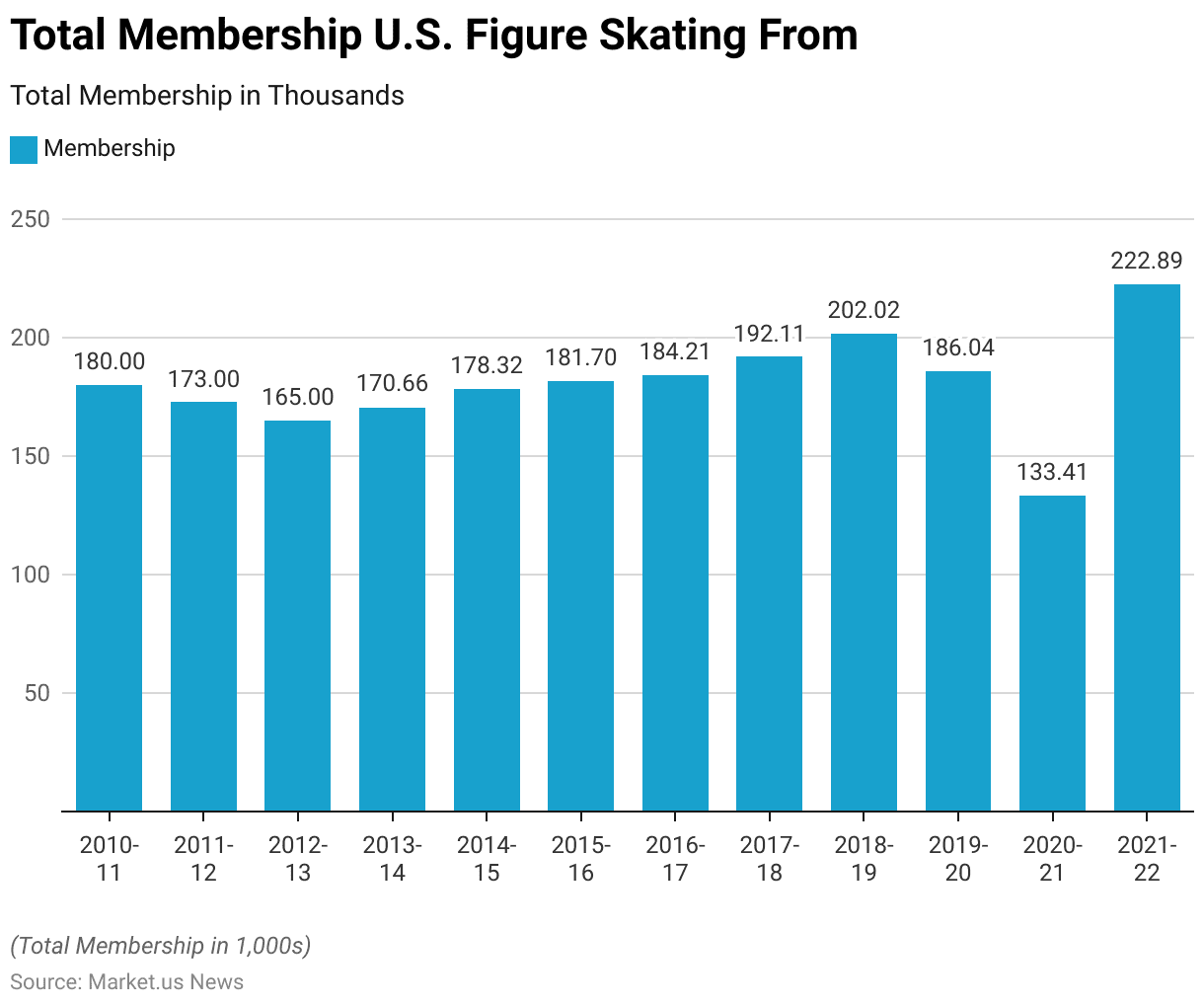
Cities with The Most Skateboard Parks in The United States Statistics
- In 2023, Laredo, Texas, boasted the highest number of skateboard parks per 100,000 residents in the United States, with a rate of 3.5 parks.
- Reno, Nevada, followed closely with 3.3 skateboard parks per 100,000 residents.
- Sacramento, California, also featured prominently, with 3.2 parks per 100,000 residents.
- Chula Vista, California, and Anaheim, California, had 2.9 and 2.6 skateboard parks per 100,000 residents, respectively.
- Colorado Springs, Colorado, provided 2.3 parks per 100,000 residents, while Long Beach, California, offered 2.2 parks per 100,000 residents.
- Fresno, California, Boise, Idaho, Las Vegas, Nevada, and Henderson, Nevada, each had 2.1 skateboard parks per 100,000 residents.
- St. Paul, Minnesota, followed with 1.9 parks per 100,000 residents, and El Paso, Texas, had 1.8 parks per 100,000 residents.
- Anchorage, Alaska, and Spokane, Washington, both offered 1.7 skateboard parks per 100,000 residents.
- This data underscores the prevalence and accessibility of skateboard parks in various cities across the United States, with notable concentrations in California and Nevada.
(Source: Statista)
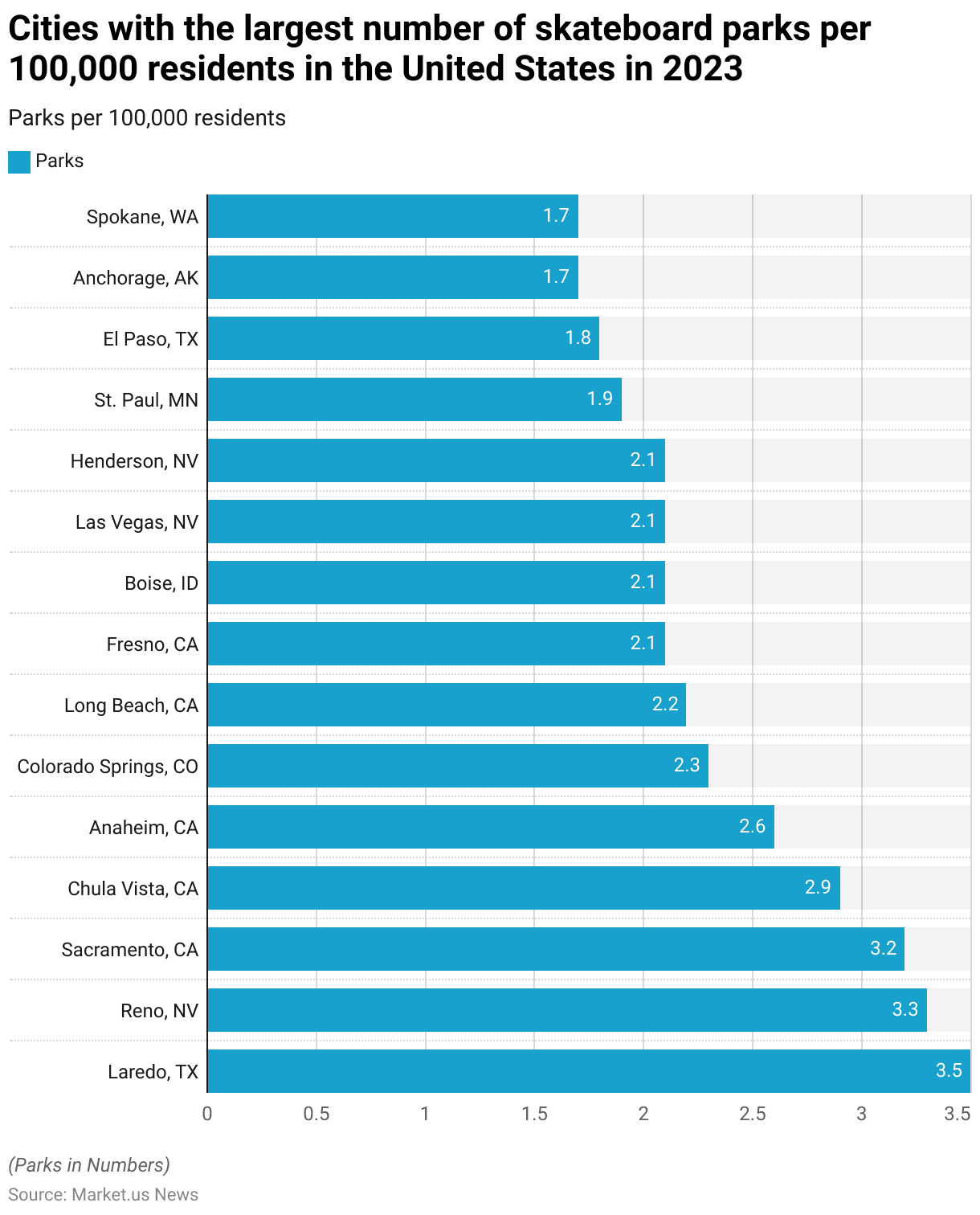
Popularity of Skateboard in the United Kingdom Statistics
Average Monthly Searches for Skateboard in U.K. Cities Statistics
- In the United Kingdom, various cities exhibit high levels of interest in skateboarding, as indicated by average monthly search volumes per 100,000 people.
- Stockport leads with 717.81 searches, followed closely by Oldham with 683.55 searches.
- Peterborough ranks third with 618.4 searches, while Warrington and Rochdale show significant interest with 568.13 and 565.2 searches, respectively.
- Bournemouth has an average of 527.99 searches, and Bristol records 522.48 searches per 100,000 people.
- Exeter and Swindon also display notable search volumes, with 519.79 and 509.75 searches, respectively.
- Huddersfield rounds out the top cities with 490.95 searches.
- These figures surpass the national average of 382.6 searches per 100,000 people, highlighting a concentrated enthusiasm for skateboarding in these cities compared to the broader U.K. population.
(Source: Our Sporting Life)
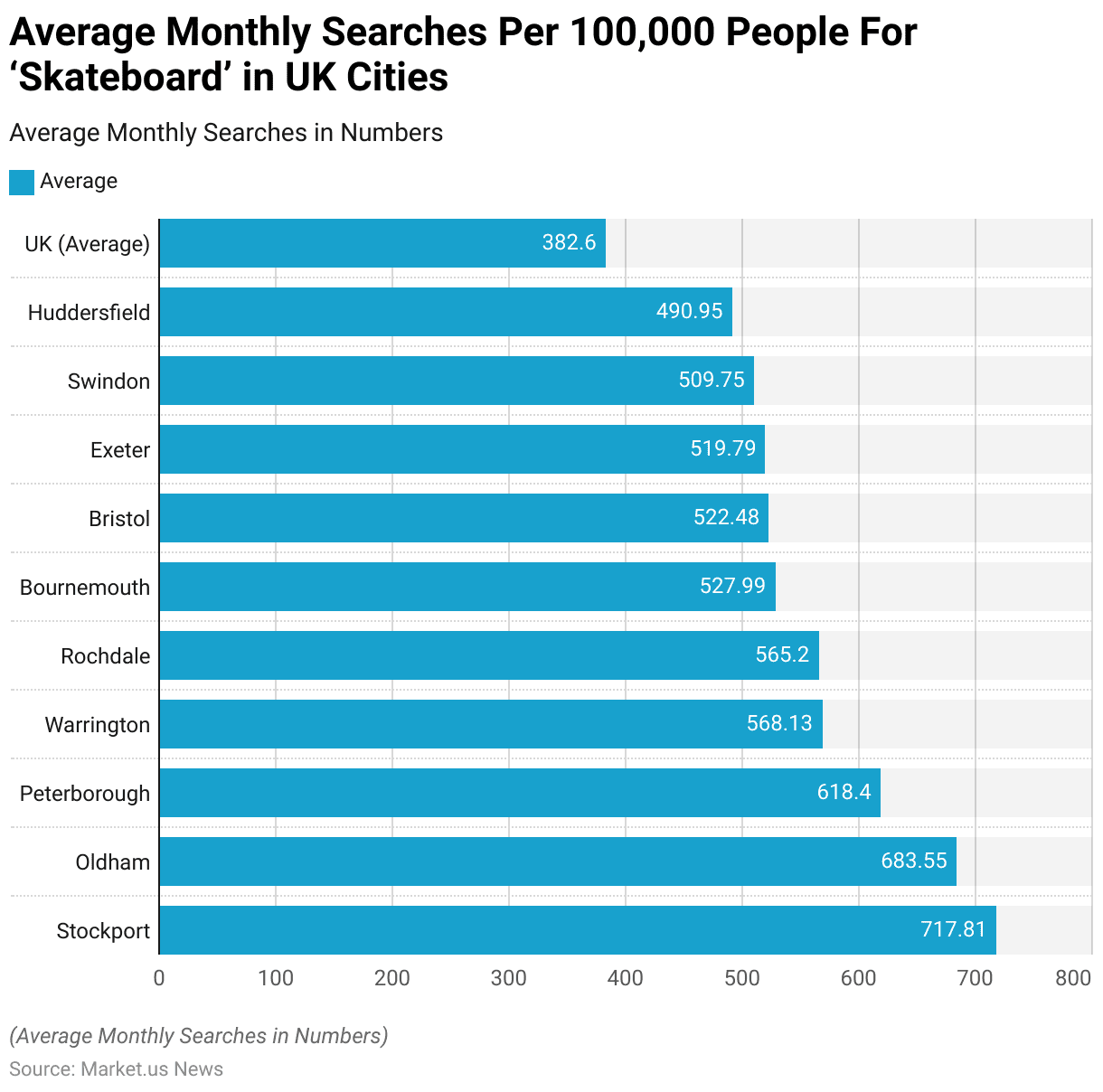
Demographics of Skateboarding Participants
Skateboard Statistics By Children
- The participation rates of children in roller skating or skateboarding in England have shown varying trends across different age groups from 2010 to 2018.
- For children aged 5-10 years, the participation rate was 4.70% in 2010-11, increasing to 5.60% in 2011-12 and peaking at 7.60% in 2015-16.
- However, this rate declined to 5.90% in 2016-17 and further to 3.30% in 2017-18.
- For the older age group of 11-15 years, the participation rate was initially 4.80% in 2010-11, slightly decreasing to 4.60% in 2011-12.
- It then rose to 6.70% in 2012-13, reaching a high of 7.80% in 2014-15.
- The rate then saw a decline to 4.90% in 2016-17 before slightly recovering to 5.40% in 2017-18.
- These fluctuations highlight the changing levels of engagement in roller skating and skateboarding among children in England over the specified period.
(Source: Statista)
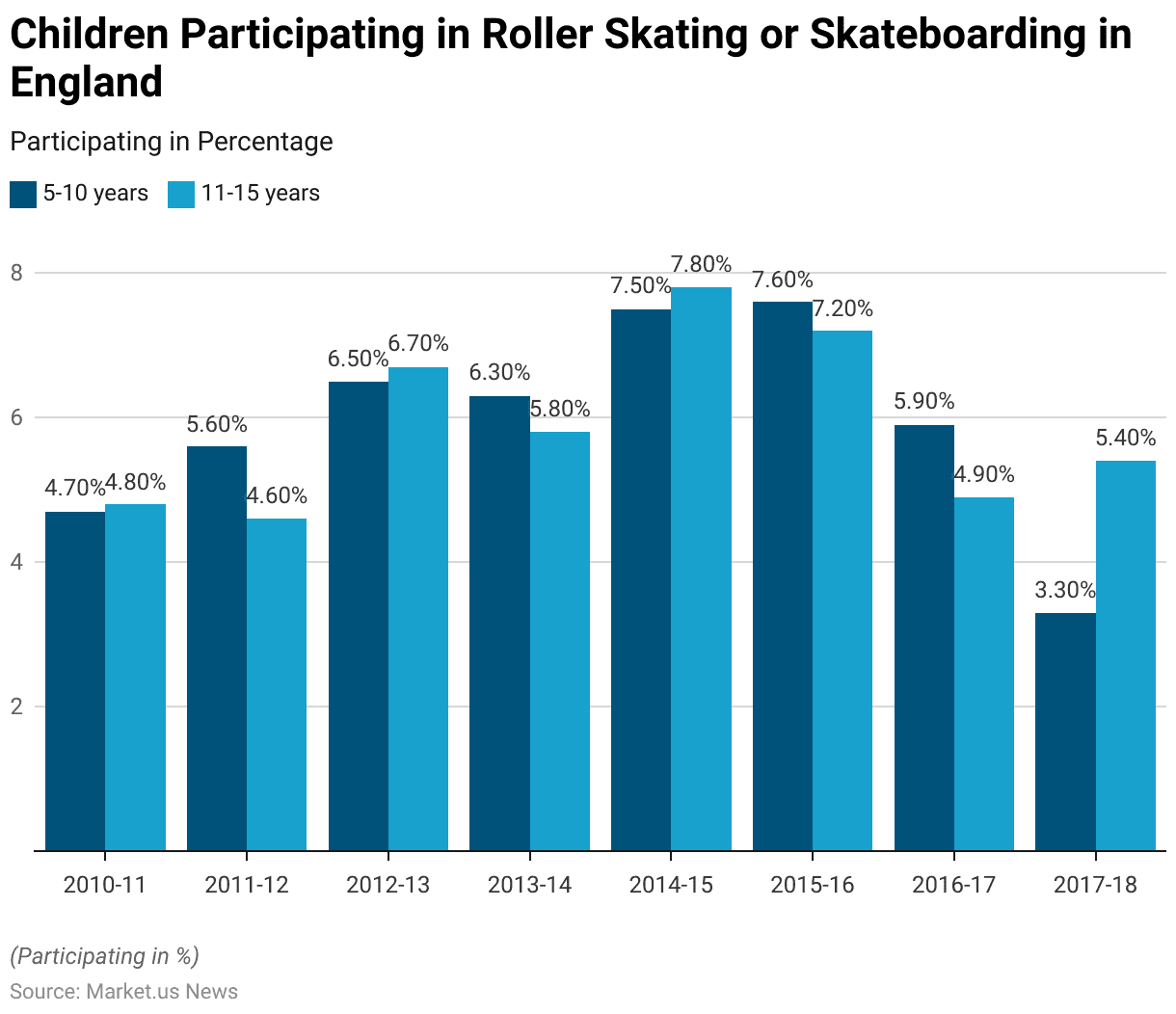
Race and Ethnicity of Skaters
- The self-identified race and ethnicity of skaters reveal a diverse community.
- LatinX individuals, encompassing Hispanic, Latino, and Spanish heritage, constitute the largest group at 36%.
- Those who identify with more than one race or ethnicity follow closely, representing 33% of the skating population.
- Asian/Pacific Islanders account for 11%, while individuals of African descent, including Black, African American, and Afro-Caribbean skaters, make up 10%.
- An additional 7% of skaters fall under the “Other” category, and 3% identify as Indian or Alaska Native.
- This data highlights the varied racial and ethnic backgrounds present within the skateboarding community.
(Source: USC 2021 Skate Study, Beyond the Board)
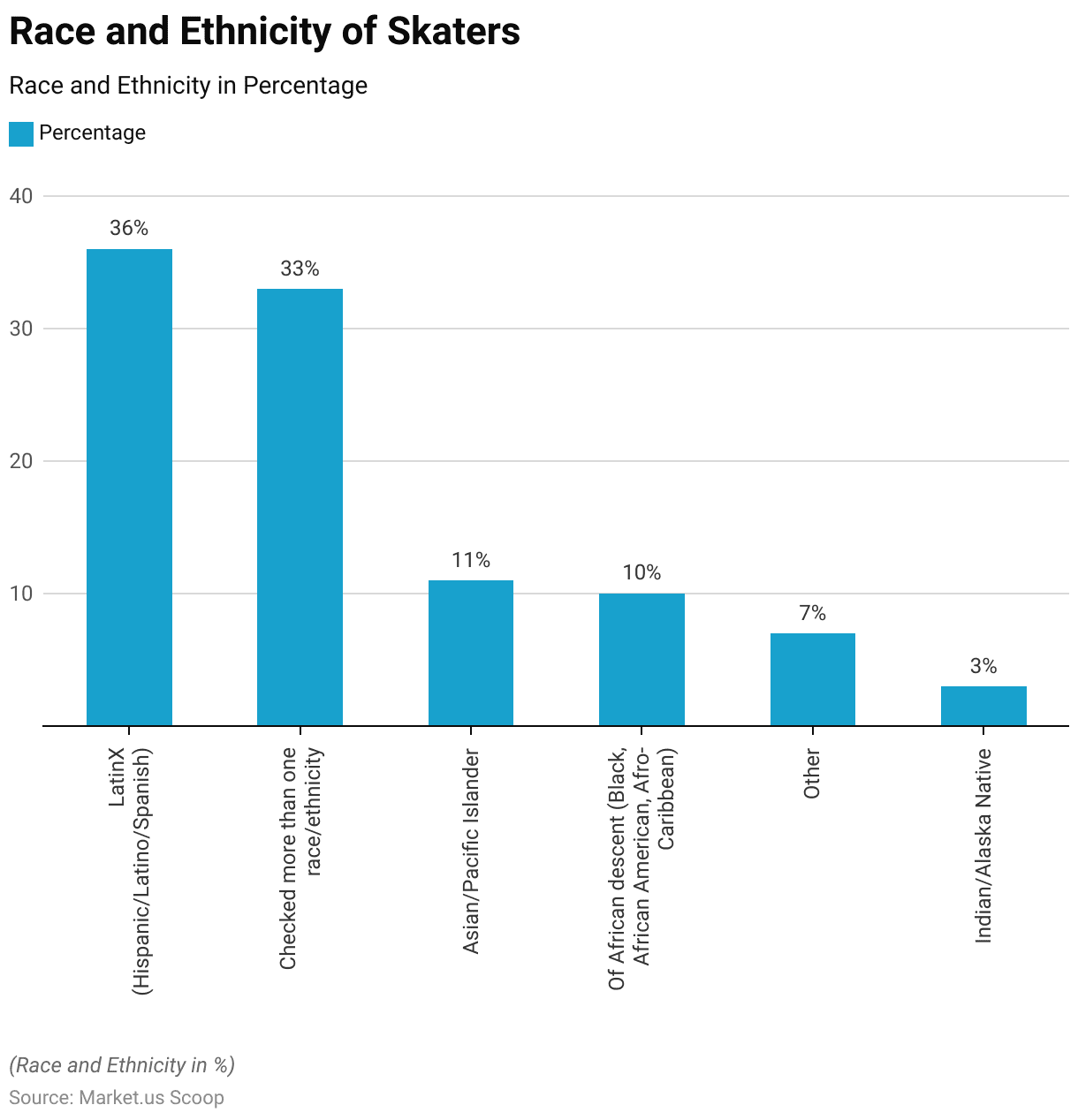
Skateboard Gender Distribution Statistics
- A study conducted in 2010 found that 8.6% of American teenagers had tried skateboarding, and 1.7% of those under 18 were regular skateboarders.
- It was also noted that 77.1% of skaters were male, with males comprising 83.4% of regular, or ‘core,’ skaters.
- Conversely, 23.9% of skaters were female, and only 16.6% of core skaters were female.
- However, recent trends indicate a significant increase in female participation in skateboarding. According to a March 2023 report by GOSKATE, women now make up 40% of all skateboarders.
- In recent data, it was found that 75% of skateboarders are male, and 72% identify as straight. Additionally, 54% of skateboarders are white, while 43% identify as skaters of color.
- In the U.K., the Duke of Edinburgh Award highlighted a significant rise in female interest in skateboarding over the past five years. In 2017, only 37 girls and women aged 14-24 registered skateboarding as their chosen activity, but by 2022, this number had surged to 353, marking an 800% increase.
(Source: Duke of Edinburgh Award, Public Skatepark Development Guide, GO SKATE)
Top Male Skaters
- In the 2017/2018 season, the top male figure skaters worldwide were led by Nathan Chen from the United States, who achieved the highest season-best total score of 321.4.
- Close behind was Shoma Uno of Japan with a score of 319.84, followed by his compatriot Yuzuru Hanyu, who earned 317.85.
- Javier Fernandez from Spain recorded an impressive 605.24, and Boyang Jin of China scored 600.95.
- Mikhail Kolyada from Russia achieved a score of 282, while Vincent Zhou from the United States garnered 276.69.
- Fellow Russians Dmitri Aliev and Sergei Voronov posted scores of 274.06 and 271.22, respectively.
- Rounding out the top ten was Jason Brown from the United States, with a season-best score of 269.22.
- This elite group of skaters demonstrated exceptional performance and skill throughout the season.
(Source: Statista)

Skateboard Motivations for Skateboarding Statistics
- A survey on the reasons why individuals skateboard revealed a variety of motivations among respondents.
- The majority, 76%, cited having fun as their primary reason for skateboarding.
- Additionally, 62% use skateboarding as a way to get away from stress, while 58% are motivated by the desire to learn tricks.
- For 57% of respondents, skateboarding serves as a medium to be creative and express themselves.
- Meeting up with friends was a key reason for 53% of the participants, and 52% skateboard for exercise.
- A smaller percentage, 37%, use skateboarding as a mode of transportation, and 26% skateboard to spend time alone.
- This data highlights the diverse and multifaceted reasons why people are drawn to skateboarding.
(Source: USC 2021 Skate Study, Beyond the Board)
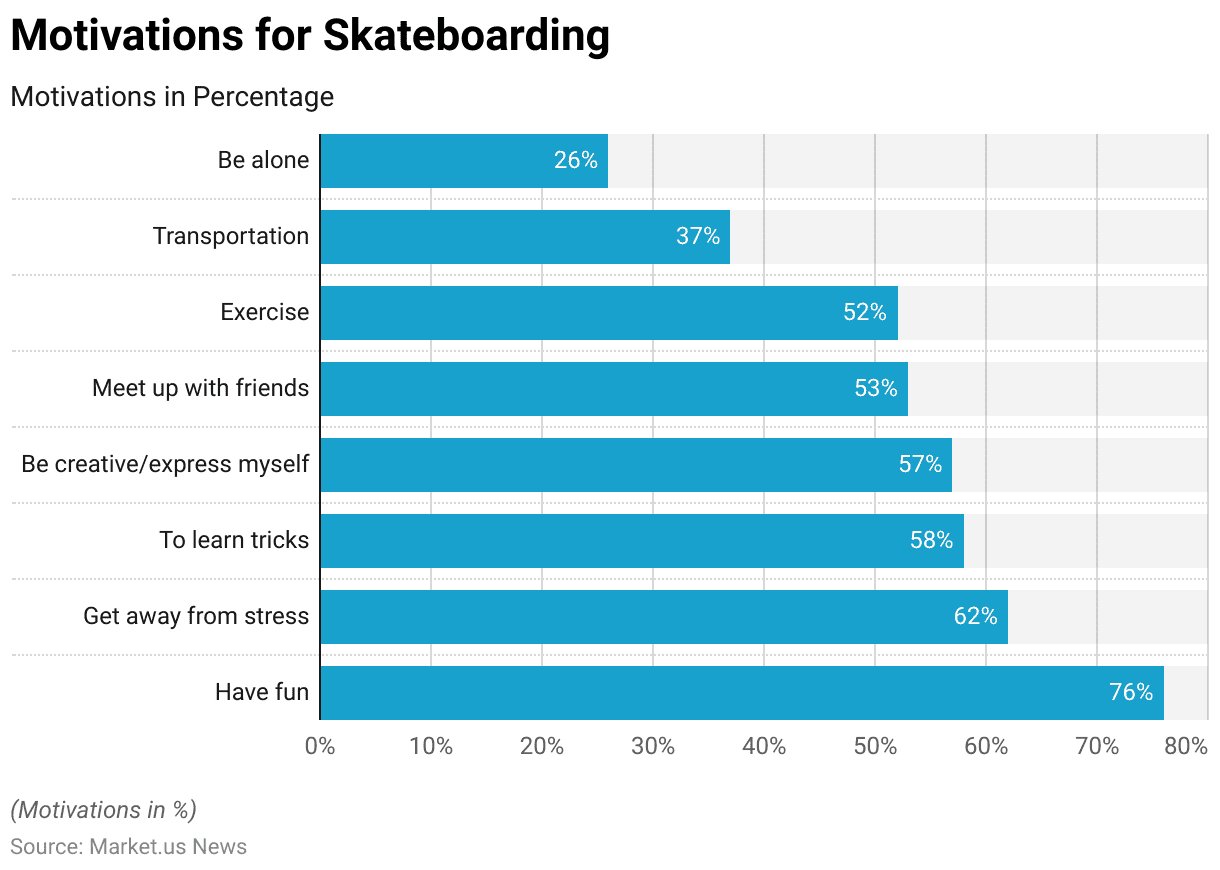
Skateboard Top Concerns and Statistics
- A survey of skateboarders under the age of 26 revealed various concerns across different demographic groups.
- Financial issues were the top concern for all groups, with 74% of all skaters, 68% of female skaters, and 68% of skaters of color indicating this as a primary concern.
- Finding a job was also significant, cited by 45% of all skaters and 41% of both female skaters and skaters of color.
- Disrespect, negativity, and hate were concerns for 44% of all skaters, with a slightly higher concern among female skaters (46%) and lower among skaters of color (36%).
- Daily responsibilities were a concern for 41% of all skaters, 39% of female skaters, and 33% of skaters of color.
- College admission worries were noted by 24% of all skaters. 28% of female skaters, and 26% of skaters of color.
- Housing issues and homelessness were concerns for 22% of all skaters, but only 12% of female skaters, while 21% of skaters of color identified this issue.
- Concerns about drugs and alcohol affected 15% of all skaters and 11% of both female skaters and skaters of color.
- Criminal justice issues were cited by 12% of all skaters and skaters of color, but only 9% of female skaters.
- Lastly, immigration issues were a concern for 9% of all skaters, 10% of female skaters, and 12% of skaters of color.
- This data underscores the varied and multifaceted concerns of young skateboarders.
(Source: USC 2021 Skate Study, Beyond the Board)
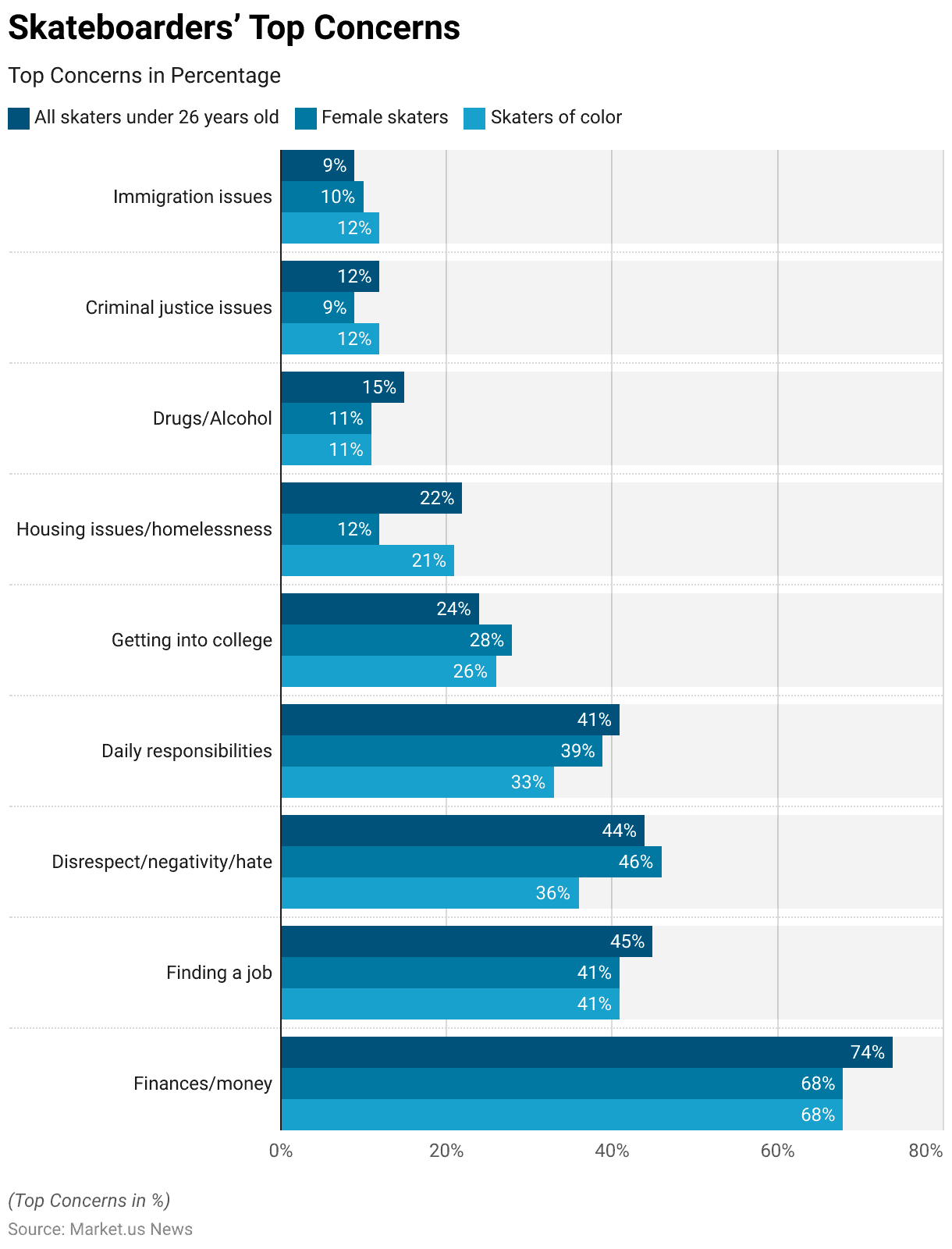
Skateboard Regulations for Skateboarding Statistics
- Skateboarding regulations vary significantly by country, reflecting local priorities on safety and public order.
- In the United States, skateboarding laws are typically set by municipalities and include mandates on helmet use. restrictions on where skateboards can be ridden (e.g., prohibitions on public streets in certain cities), and age requirements.
- For instance, in California, skateboarders under 18 are required to wear helmets, and skateboarding on public streets is largely restricted.
- In contrast, the U.K. has stringent rules, often categorizing skateboards similarly to vehicles, thereby imposing limits on their use on public roads and requiring protective gear.
- In Japan, skateboarding is generally limited to designated skate parks, and helmet use is strongly recommended, though not always mandated. As skateboarding becomes more popular globally, electric skateboards are also seeing specific regulations.
- These include speed limits typically set between 20-25 km/h, mandatory helmet use, and sometimes requirements for registration and insurance.
(Sources: World Skate, Index Skateboarding)
Recent Developments
Acquisitions and Mergers:
- Globe International acquires Dwindle Distribution: In mid-2023, Globe International acquired Dwindle Distribution, a leading skateboard company, for $45 million. This acquisition aims to expand Globe’s product offerings and strengthen its position in the global skateboard market.
- Zumiez acquires Blue Tomato: In late 2023, Zumiez, a major retailer of action sports equipment, completed its $75 million acquisition of Blue Tomato, an online retailer specializing in skateboards and related gear. This merger is expected to enhance Zumiez’s online presence and broaden its customer base in Europe.
New Product Launches:
- Element’s Eco-Friendly Skateboards: In early 2024, Element Skateboards launched a new line of eco-friendly skateboards made from sustainably sourced wood and recycled materials. This product line aims to attract environmentally conscious consumers and reduce the brand’s carbon footprint.
- Electric Skateboards by Boosted: Boosted introduced a new range of electric skateboards in mid-2023, featuring improved battery life, faster speeds, and enhanced safety features. These boards are designed for urban commuters seeking an efficient and eco-friendly mode of transportation.
Funding:
- Revive Skateboards secures $15 million: In 2023, Revive Skateboards, a popular brand among young skaters, raised $15 million in a funding round to expand its product line, enhance its manufacturing capabilities, and invest in marketing initiatives to increase brand awareness.
- Evolve Skateboards raises $20 million: Evolve Skateboards, known for its high-performance electric skateboards, secured $20 million in early 2024 to develop new models, improve battery technology, and expand its global distribution network.
Technological Advancements:
- Smart Skateboards: Advances in smart technology are being integrated into skateboards to provide features such as GPS tracking, speed monitoring, and performance analytics. These smart skateboards offer enhanced safety and a more interactive riding experience.
- Sustainable Materials: The development of new sustainable materials, such as bamboo and bio-based composites, is improving the environmental footprint of skateboards while maintaining performance and durability.
Market Dynamics:
- Growth in Skateboard Market: The global skateboard market is projected to grow at a CAGR of 5.1% from 2023 to 2028, driven by the increasing popularity of action sports, rising demand for eco-friendly products, and the expansion of e-commerce platforms.
- Rising Popularity Among Youth: Skateboarding continues to gain popularity among young people, particularly in urban areas, contributing to market growth and increased sales of skateboards and related accessories.
Regulatory and Strategic Developments:
- Olympic Inclusion: Skateboarding was included in the Olympic Games for the first time in Tokyo 2021, and its continued inclusion in future games is expected to drive interest and participation in the sport, boosting market growth.
- Safety Standards: New safety standards for skateboards were introduced in early 2024 by the Consumer Product Safety Commission (CPSC) in the US, focusing on improving the design and manufacturing processes to ensure rider safety.
Research and Development:
- Enhanced Deck Designs: R&D efforts are focusing on developing enhanced deck designs that offer better flexibility, strength, and shock absorption, improving the overall riding experience and durability of skateboards.
- Electric Skateboard Batteries: Researchers are working on improving battery technology for electric skateboards, aiming to increase energy density, reduce charging times, and extend the overall lifespan of the batteries, making electric skateboards more practical and reliable.
Conclusion
Skateboard Statistics – The data on skateboarding highlights its growing popularity and diverse participation. With notable increases in female skaters and skaters of color.
Motivations for skateboarding include fun, stress relief, creativity, and social interaction. Common concerns among skaters, especially those under 26, include financial issues, job search challenges, and social negativity.
Despite these challenges, skateboarding remains a vibrant and culturally significant sport. The rise in inclusivity and the sport’s dynamic subculture underscore its enduring appeal and the importance of addressing community concerns to sustain its growth.
FAQs
There are various types of skateboards, including street boards, cruiser boards, longboards, and specialty boards like electric skateboards.
Common terms include “deck” (the board), “trucks” (axles), “wheels,” “bearings,” “grip tape,” “ollie” (a jump), “kickflip” (a flipping trick), and “grind” (sliding on the trucks).
Yes, skateboarding provides a full-body workout, improves balance and coordination, and enhances cardiovascular health.
Street skating involves tricks and maneuvers performed on urban obstacles like stairs, rails, and ledges. Vert skating is done on ramps and half-pipes, focusing on aerial tricks and spins.
Skateboarding is generally environmentally friendly and it is human-powered. However, manufacturing decks, trucks, and wheels do have an environmental impact. Some companies focus on sustainable practices to mitigate this.
Discuss Your Needs With Our Analyst
Please share your requirements with more details so our analyst can check if they can solve your problem(s)




